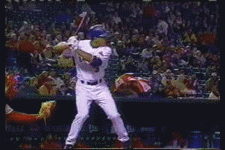quote:Originally posted by BobbleheadDoll:
What you are seeing is an adjustment to the ball coming inj not a push. The stride which I always had a big one but most teach to have a short one requires a shift and the back leg colapses slightly.
Once the front leg is down it just rotates as does the back foot. I always had as little lower body movement after striding as it set up the stable support of my upperbody as I swung the bat Too much movement makes it hard to make proper contact which is the most important thing when hitting a ball.
The back leg reacts to the force applied to the ball. The front leg is stationary and forms a 45% angle after impact giving you max power.
If you push off the back leg you will have problems with contact. The weight of the body is kept back.
I agree with what you are saying. I only use the word "push" in the context of this thread. Although it seems everyone has a different way of defining and using that word. I hate using that word too.
The better word to describe what's happening in the back hip is "resistance". There is tension there in the muscles. It may or may not always result in movement. Muscles can do work without changing joint angles. I hope Quincy has figured this out.






